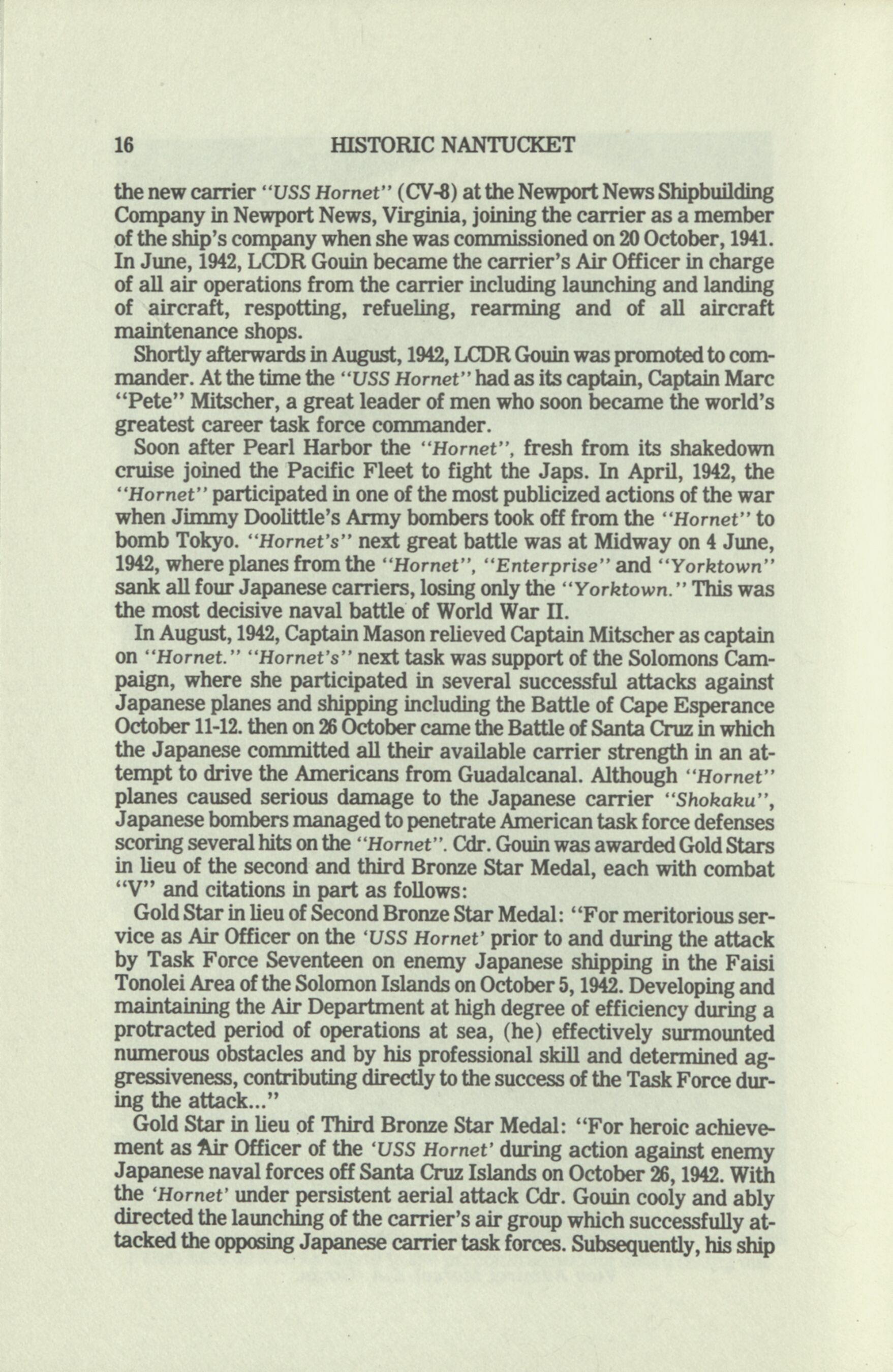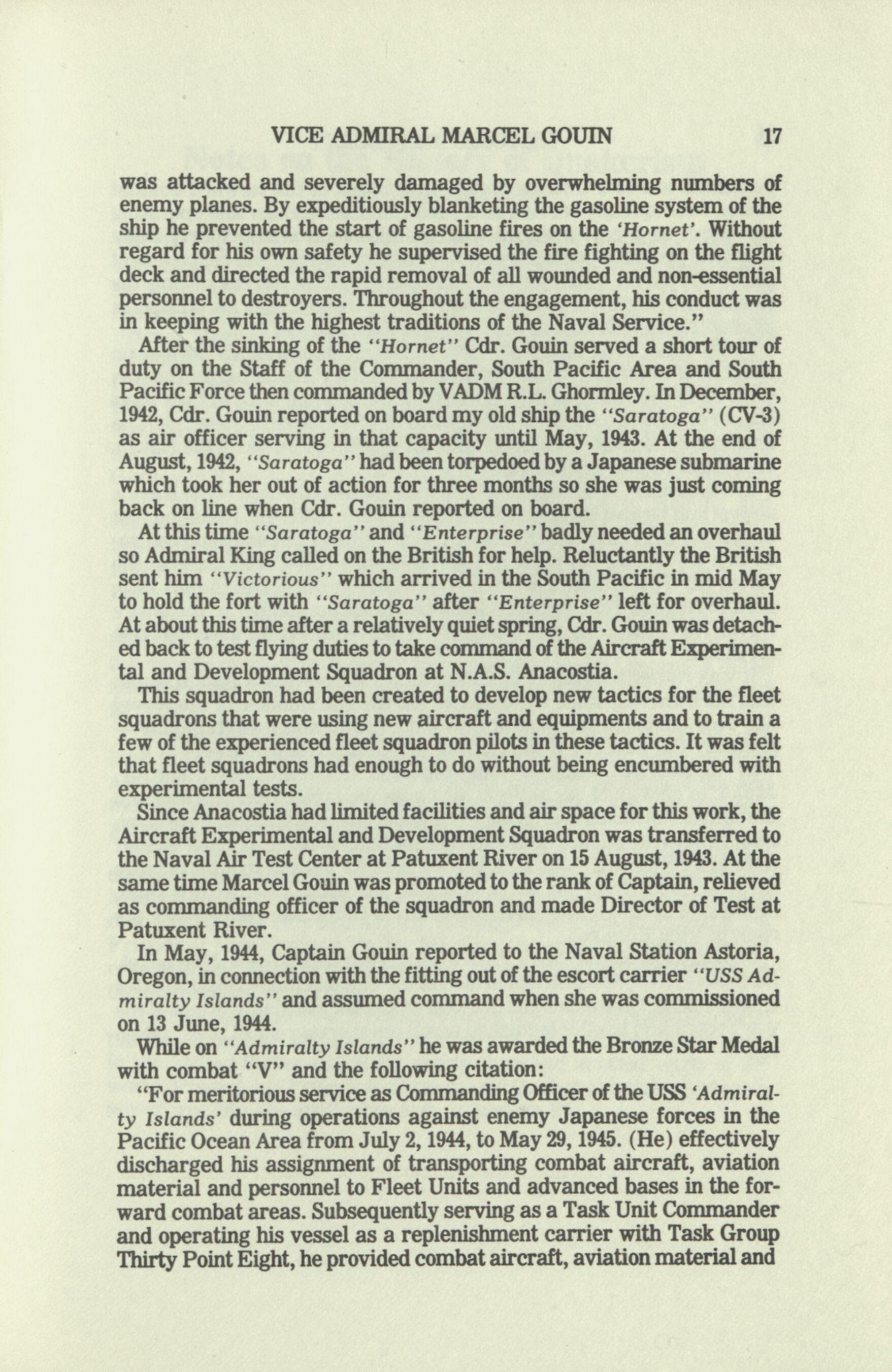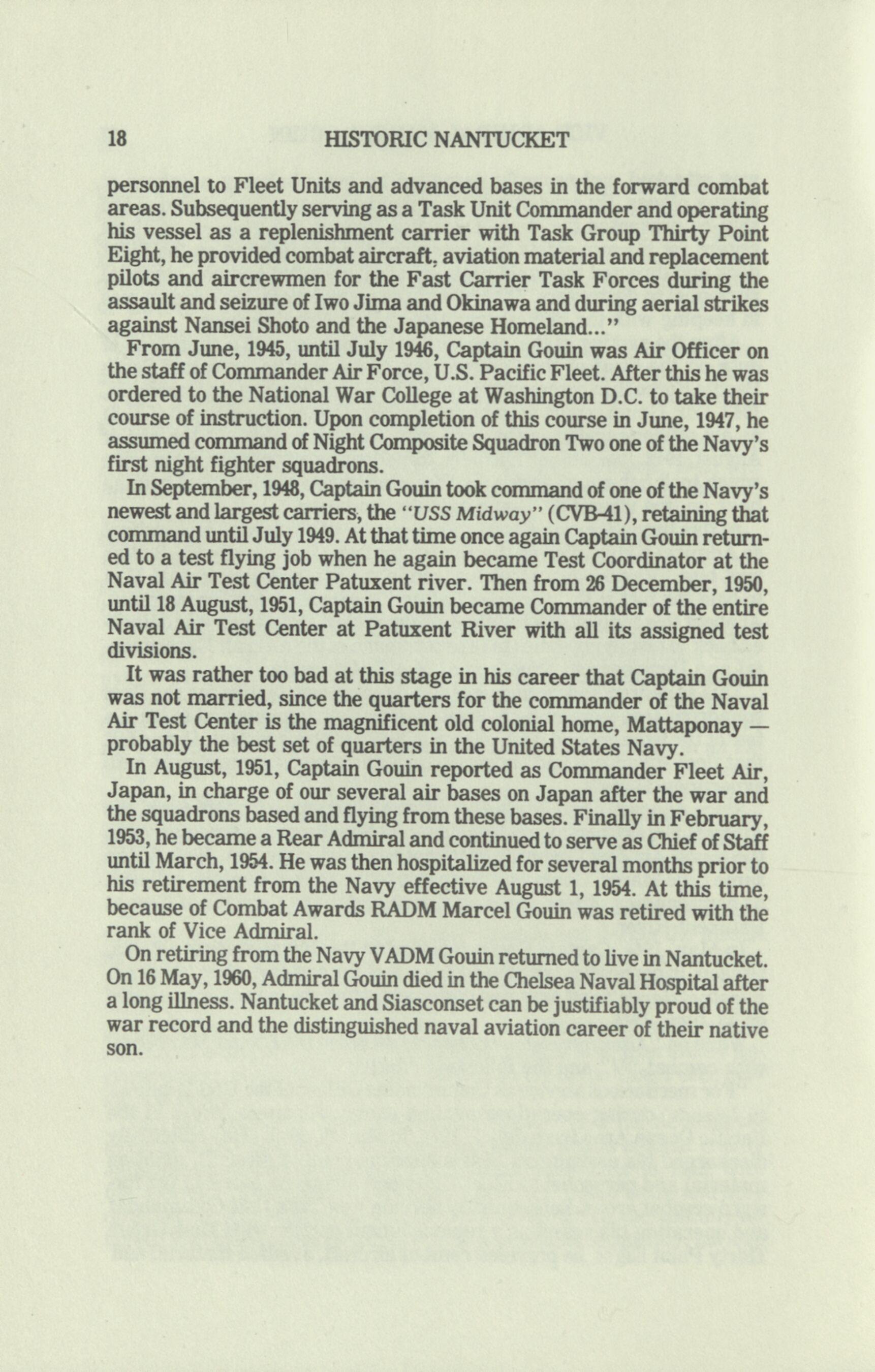
9 minute read
by J. E. Lacouture
14
Vice Admiral Marcel Gouin 'Sconset's Gift to Naval Aviation
by J. E. Lacouture
RECENTLY I WAS DOWN at the Naval Air Test Center at Patuxent River researching an article on the Tactical Test Division, where I had spent several fascinating years of flying. During my investigations the name Marcel Gouin kept appearing and when I entered the Admiral's office there his picture was on the wall as a former Commander of the Naval Air Test Center. Since we both had 'Sconset/Nantucket backgrounds I could no longer resist an article.
Marcel Emile Alcan Gouin was born in Siasconset on 29 June, 1900, son of Marcel E. and Mary (Lowell) Gouin. After receiving his early schooling on Nantucket, he attended Tabor Academy in Marion, Massachusetts, and the Severna Annapolis Preparatory School in Severna Park, Maryland, before entering the U.S. Naval Academy in 1920 after receiving an appointment from his local congressman. Midshipman Gouin graduated from the Naval Academy and was commissioned Ensign on 4 June, 1924.
As was customary in those days after graduating from the Naval Academy in June, 1924, he had sea duty until February, 1928, serving consecutively on the battleship "USS West Virginia" and destroyers
"USS Sloat", "USS Shirk" and "USS Barry".
On 2 March, 1928, Lt. (j.g.) Gouin reported to the Naval Air Station, Pensacola, to begin flight training and received his wings as a Naval Aviator on 4 January, 1929.
In March, 1929, he joined Scouting Squadron 3, based on the aircraft carrier "Lexington" — one of the Navy's famous original carrier squadrons. Lt (j.g.) Gouin flew with that squadron until July, 1931, when he was ordered to report to Naval Air Station Pensacola as a flight instructor.
In September, 1933, Lt. Gouin reported to the Newport News Shipbuilding Company where the "USS Ranger", the Navy's fourth carrier and the first to be built from the start as a carrier, was completing building. He served aboard the "Ranger" from her commissioning June 4,1934, until July, 1935, when he joined Fighting Squadron 1 based initially on the carrier "USS Langley" and later on the "USS Lexington." From June, 1937, to May, 1940, LCDR Gouin had duty in the Bureau of Aeronautics Flight Test Section at the Naval Air Station, Anacostia, D.C. At the same time from September, 1937, until November, 1939, he had additional duty as one of the Naval Aides to President Roosevelt.
In his next assignment LCDR Gouin achieved one of the goals of all naval aviators - Command of a carrier squadron when he commanded Bombing Squadron Six based on the aircraft carrier "USS Enterprise" from June, 1940, to June, 1941.
From here he was assigned to the precommissioning detail fitting out

16
HISTORIC NANTUCKET
the new carrier "USS Hornet" (CV-8) at the Newport News Shipbuilding Company in Newport News, Virginia, joining the carrier as a member of the ship's company when she was commissioned on 20 October, 1941. In June, 1942, LCDR Gouin became the carrier's Air Officer in charge of all air operations from the carrier including launching and landing of aircraft, respotting, refueling, rearming and of all aircraft maintenance shops.
Shortly afterwards in August, 1942, LCDR Gouin was promoted to commander. At the time the "USS Hornet" had as its captain, Captain Marc "Pete" Mitscher, a great leader of men who soon became the world's greatest career task force commander.
Soon after Pearl Harbor the "Hornet", fresh from its shakedown cruise joined the Pacific Fleet to fight the Japs. In April, 1942, the "Hornet" participated in one of the most publicized actions of the war when Jimmy Doolittle's Army bombers took off from the "Hornet" to bomb Tokyo. "Hornet's" next great battle was at Midway on 4 June,
1942, where planes from the "Hornet", "Enterprise" and "Yorktown" sank all four Japanese carriers, losing only the "Yorktown." This was the most decisive naval battle of World War II.
In August, 1942, Captain Mason relieved Captain Mitscher as captain on "Hornet." "Hornet's" next task was support of the Solomons Campaign, where she participated in several successful attacks against Japanese planes and shipping including the Battle of Cape Esperance October 11-12. then on 26 October came the Battle of Santa Cruz in which the Japanese committed all their available carrier strength in an attempt to drive the Americans from Guadalcanal. Although "Hornet" planes caused serious damage to the Japanese carrier "Shokaku Japanese bombers managed to penetrate American task force defenses scoring several hits on the "Hornet". Cdr. Gouin was awarded Gold Stars in lieu of the second and third Bronze Star Medal, each with combat "V" and citations in part as follows:
Gold Star in lieu of Second Bronze Star Medal: "For meritorious service as Air Officer on the 'USS Hornet' prior to and during the attack by Task Force Seventeen on enemy Japanese shipping in the Faisi Tonolei Area of the Solomon Islands on October 5,1942. Developing and maintaining the Air Department at high degree of efficiency during a protracted period of operations at sea, (he) effectively surmounted numerous obstacles and by his professional skill and determined aggressiveness, contributing directly to the success of the Task Force during the attack..."
Gold Star in lieu of Third Bronze Star Medal: "For heroic achievement as Air Officer of the 'USS Hornet' during action against enemy Japanese naval forces off Santa Cruz Islands on October 26,1942. With the 'Hornet' under persistent aerial attack Cdr. Gouin cooly and ably directed the launching of the carrier's air group which successfully attacked the opposing Japanese carrier task forces. Subsequently, his ship

VICE ADMIRAL MARCEL GOUIN 17
was attacked and severely damaged by overwhelming numbers of enemy planes. By expeditiously blanketing the gasoline system of the ship he prevented the start of gasoline fires on the 'Hornet'. Without regard for his own safety he supervised the fire fighting on the flight deck and directed the rapid removal of all wounded and non-essential personnel to destroyers. Throughout the engagement, his conduct was in keeping with the highest traditions of the Naval Service."
After the sinking of the "Hornet" Cdr. Gouin served a short tour of duty on the Staff of the Commander, South Pacific Area and South Pacific Force then commanded by VADM R.L. Ghormley. In December, 1942, Cdr. Gouin reported on board my old ship the "Saratoga" (CV-3) as air officer serving in that capacity until May, 1943. At the end of August, 1942, "Saratoga" had been torpedoed by a Japanese submarine which took her out of action for three months so she was just coming back on line when Cdr. Gouin reported on board.
At this time "Saratoga" and "Enterprise" badly needed an overhaul so Admiral King called on the British for help. Reluctantly the British sent him "Victorious" which arrived in the South Pacific in mid May to hold the fort with "Saratoga" after "Enterprise" left for overhaul. At about this time after a relatively quiet spring, Cdr. Gouin was detached back to test filing duties to take command of the Aircraft Experimental and Development Squadron at N.A.S. Anacostia.
This squadron had been created to develop new tactics for the fleet squadrons that were using new aircraft and equipments and to train a few of the experienced fleet squadron pilots in these tactics. It was felt that fleet squadrons had enough to do without being encumbered with experimental tests.
Since Anacostia had limited facilities and air space for this work, the Aircraft Experimental and Development Squadron was transferred to the Naval Air Test Center at Patuxent River on 15 August, 1943. At the same time Marcel Gouin was promoted to the rank of Captain, relieved as commanding officer of the squadron and made Director of Test at Patuxent River.
In May, 1944, Captain Gouin reported to the Naval Station Astoria, Oregon, in connection with the fitting out of the escort carrier "USS Admiralty Islands" and assumed command when she was commissioned on 13 June, 1944.
While on "Admiralty Islands" he was awarded the Bronze Star Medal with combat "V" and the following citation: "For meritorious service as Commanding Officer of the USS 'Admiralty Islands' during operations against enemy Japanese forces in the Pacific Ocean Area from July 2,1944, to May 29,1945. (He) effectively discharged his assignment of transporting combat aircraft, aviation material and personnel to Fleet Units and advanced bases in the forward combat areas. Subsequently serving as a Task Unit Commander and operating his vessel as a replenishment carrier with Task Group Thirty Point Eight, he provided combat aircraft, aviation material and

18
HISTORIC NANTUCKET
personnel to Fleet Units and advanced bases in the forward combat areas. Subsequently serving as a Task Unit Commander and operating his vessel as a replenishment carrier with Task Group Thirty Point Eight, he provided combat aircraft, aviation material and replacement pilots and aircrewmen for the Fast Carrier Task Forces during the assault and seizure of Iwo Jima and Okinawa and during aerial strikes against Nansei Shoto and the Japanese Homeland..."
From June, 1945, until July 1946, Captain Gouin was Air Officer on the staff of Commander Air Force, U.S. Pacific Fleet. After this he was ordered to the National War College at Washington D.C. to take their course of instruction. Upon completion of this course in June, 1947, he assumed command of Night Composite Squadron Two one of the Navy's first night fighter squadrons.
In September, 1948, Captain Gouin took command of one of the Navy's newest and largest carriers, the "USS Midway" (CVB-41), retaining that command until July 1949. At that time once again Captain Gouin returned to a test flying job when he again became Test Coordinator at the Naval Air Test Center Patuxent river. Then from 26 December, 1950, until 18 August, 1951, Captain Gouin became Commander of the entire Naval Air Test Center at Patuxent River with all its assigned test divisions.
It was rather too bad at this stage in his career that Captain Gouin was not married, since the quarters for the commander of the Naval Air Test Center is the magnificent old colonial home, Mattaponay — probably the best set of quarters in the United States Navy.
In August, 1951, Captain Gouin reported as Commander Fleet Air, Japan, in charge of our several air bases on Japan after the war and the squadrons based and flying from these bases. Finally in February, 1953, he became a Rear Admiral and continued to serve as Chief of Staff until March, 1954. He was then hospitalized for several months prior to his retirement from the Navy effective August 1, 1954. At this time, because of Combat Awards RADM Marcel Gouin was retired with the rank of Vice Admiral.
On retiring from the Navy VADM Gouin returned to live in Nantucket. On 16 May, 1960, Admiral Gouin died in the Chelsea Naval Hospital after a long illness. Nantucket and Siasconset can be justifiably proud of the war record and the distinguished naval aviation career of their native son.










